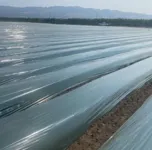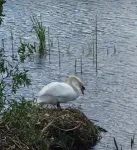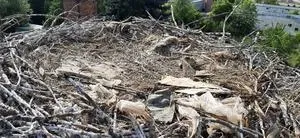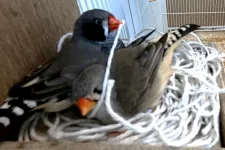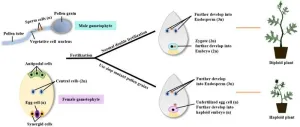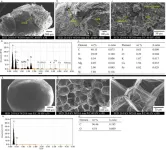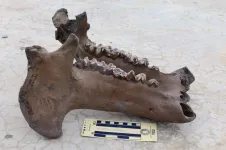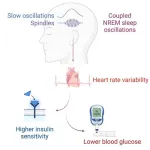(Press-News.org) Researchers have found that the plastic mulch used to support the growth of Californian strawberries sheds large quantities of plastic mulch fragments. These particles have been shown to negatively impact soil qualities, casting doubt on the long-term viability of their use. The findings from the survey are likely to apply world-wide to plastic use in agricultural production.
Presenting their work at the Goldschmidt geochemistry conference in Lyon, postdoctoral researcher Dr Ekta Tiwari (from Sistla group at California Polytechnic State University) said “What we are seeing a huge quantity of macroplastic plastic material – particles bigger than 5mm across -being shed where the mulch is used to enhance strawberry production. These can remain in the soil for decades or longer”.
Plastics, such as polyethylene, are increasingly used in agriculture, for example in polytunnels. Plastic mulch films are extensively used in agriculture, where they provide a range of benefits. They are tucked in around the base of the plant, which can help control weeds and pathogens, reduce water evaporation, and prevent soil splashing on fruit (which is particularly important for strawberries).
The mulch is applied in rows and then removed after the crop’s seasonal production is complete. However, even careful land stewardship by farmers does not ensure all the plastic is removed because fragments get left behind and adhere to the soil during removal. After decades of annual plastic mulch application and removal, the researchers observed the accumulation of plastic fragments within farm soils, even in really well-managed fields. The researchers looked for macroplastics, which are plastic pieces more than 5mm across.
Ekta Tiwari continued “We carried out a systematic survey of strawberry fields after the seasonal removal of these plastic film. We found that the distribution was fairly uniform. On field surfaces alone, we found up to 213,500 macroplastic particles per hectare. That doesn’t include subsurface particles, which we did not survey. In addition, we are currently analysing the same soil samples for microplastics, which are smaller particles, less than 5mm across; these are not yet included in our findings”.
Note: A hectare is 10,000 square metres. For comparison, an average professional soccer playing pitch is around 7100 square metres.
Most of the particles are polyethylene (identified using Fourier transform infrared spectroscopy). In preliminary findings, the researchers found that as the levels of macroplastic pollution increased, soil moisture content, microbial respiration, and plant-available nitrogen declined.
Dr. Tiwari added “The plastic mulch provides benefits, but at the expense of long-term soil quality. It’s difficult and expensive to remove these particles from the soil, so once they are there they can stay there indefinitely”.
We tend to think that strawberries are simply things to be enjoyed, but this shows that even something as delicious as fresh strawberries can come with a cost to the environment. We are working with the manufacturers to see if we can mitigate these costs”.
There are alternatives to using polyethylene mulches, such as biodegradable plastic mulches, or natural mulches such as straw, but these choices come with an economic l cost. However, the use of plastics in agriculture is also increasingly regulated, see for example European Union information at https://environment.ec.europa.eu/system/files/2021-09/Agricultural%20Plastics%20Final%20Report.pdf
Commenting, Professor Sean Schaeffer (Department of Biosystems Engineering & Soil Science, University of Tennessee, USA) said:
“Plastics, and plastic mulches in particular, are vital to maintain agricultural production. They are used for various purposes including soil moisture retention, soil warming/cooling, as well as weed or pest control. Agricultural plastic use is increasing worldwide, with California being the largest user of agricultural plastic in the US. Research on the fate and transport of plastics in soil and water systems is relatively recent, so studies like this are vital to increasing our understanding of the scope the plastic problem. We currently know relatively little about the distribution, size, and types of plastic in soils in the largest states, both in land area and in agricultural production”.
This is an independent comment, Professor Schaeffer was not involved in this work.
This work is ongoing and has not yet been peer-reviewed. The researchers are currently evaluating the level of microplastic pollution (particles smaller than 5mm) left by plastic mulches. This study provides baseline data to understand the extent of plastic pollution in the U.S. agriculture system and can help improve land management practices by assessing the biogeochemical consequences of plastic accumulation in agricultural soils.
The Goldschmidt Conference is the world’s main geochemistry conference. It is a joint congress of the European Association of Geochemistry and the Geochemical Society (US). It takes place in Lyon, France, from 9-14 July. Almost 5000 delegates are expected to attend. https://conf.goldschmidt.info/goldschmidt/2023/goldschmidt/2023/meetingapp.cgi
ENDS
END
The material a bird selects for its nest depends on the dimensions of its beak, according to researchers.
Using data on nest materials for nearly 6,000 species of birds, a team based at the University of Bristol and the University of St Andrews utilised random forest models, a type of machine learning algorithm, to take data from bird beaks and try to predict what nest materials that species might use.
They found a surprisingly strong correlation. Using only information on beak shape and size, they were able to correctly predict broad nest material use in 60% of species, rising to ...
Warmer springs are causing British bees to wake up earlier, a new study has found, threatening the pollination of crops such as apples and pears.
The research – which is believed to be the largest of its kind in Great Britain – found that for every 1 degree Celsius rise in temperature caused by climate change, wild bees, such as bumblebees, emerge from their nests 6.5 days earlier on average.
As spring starts earlier and bees emerge closer to the start of the year, they may lose sync with the plants on which ...
We all discard a huge amount of plastic and other man-made materials into the environment, and these are often picked up by birds. New research has shown that 176 bird species around the world are now known to include a wide range of anthropogenic materials in their nests. All over the world, birds are using our left-over or discarded materials. Seabirds in Australia incorporate fishing nets into their nests, ospreys in North America include baler twine, birds living in cities in South America add ...
Generating haploid plants for the purpose of obtaining pure doubled haploid (DH) lines is widely recognized as one of the most efficient breeding strategies in modern agriculture. Watermelon (Citrullus lanatus), an important fruit crop known for its nutritional value and flavor, has undergone long-term artificial selection resulting in genetic narrowing. Therefore, there is an urgent need for a haploid induction system to enhance traditional breeding methods and facilitate the development of valuable pure DH lines.
In March 2023, the Plant Biotechnology Journal published an online paper titled "Production of double haploid watermelon via ...
Tokyo, Japan – A team led by researchers from Tokyo Metropolitan University studied how microplastics in the environment accumulate heavy metals. As the microplastics spread, so do their toxic cargo. Focusing on polystyrene foam, they collected particles along a river running through Ulaanbaatar, Mongolia. They found significant levels of heavy metals accumulated on the particles, reflecting local land use and industries, as well as surface features like holes and biofilms which help pollutants collect.
The spread of plastic debris into the natural environment is an ecological disaster. As plastic waste makes ...
Extinct dwarf hippos that once roamed Madagascar lived in forests rather than open grasslands preferred by common hippos on mainland Africa, researchers at the University of Cincinnati discovered.
The findings suggest grasslands that now cover much of the enormous island off the eastern coast of southern Africa were a relatively recent change facilitated by people rather than a natural habitat sustained in part by these famously large vegetarians.
The study was published in the journal Plants, People, Planet.
When Madagascar broke away from Africa’s mainland 150 million years ago, its plants and animals evolved in geographic isolation in the ...
Researchers have known that a lack of quality sleep can increase a person’s risk of diabetes. What has remained a mystery, however, is why.
Now, new findings from a team of sleep scientists at the University of California, Berkeley, are closer to an answer. The researchers have uncovered a potential mechanism in humans that explains how and why deep-sleep brain waves at night are able to regulate the body’s sensitivity to insulin, which in turn improves blood sugar control the next day.
“These synchronized brain waves act like a finger that flicks the ...
July 7, 2023 – Patients undergoing bilateral total knee arthroplasty (TKA) are at an increased risk of several types of complications, as compared with matched patients undergoing unilateral TKA, reports a study in The Journal of Bone & Joint Surgery. The journal is published in the Lippincott portfolio in partnership with Wolters Kluwer.
"Patients who underwent simultaneous bilateral TKA were at higher risk of experiencing postoperative complications such ...
ITHACA, N.Y. -- With artificial intelligence poised to assist in profound scientific discoveries that will change the world, Cornell is leading a new $11.3 million center focused on human-AI collaboration that uses mathematics as a common language.
The Scientific Artificial Intelligence Center, or SciAI Center, is being launched with a grant from the Office of Naval Research and is led by Christopher J. Earls, professor of civil and environmental engineering at Cornell Engineering. Co-investigators include Nikolaos Bouklas, assistant professor ...
July 7, 2023 – Fifty percent of patients with metastatic prostate cancer experience some level of financial hardship due to their treatment, according to a study in the August issue of The Journal of Urology®, an Official Journal of the American Urological Association (AUA). The journal is published in the Lippincott portfolio by Wolters Kluwer.
"Our findings help in understanding the rates of and risk factors for financial toxicity among patients with advanced prostate cancer, along with the coping mechanisms, including the impact on personal spending, experienced by those reporting higher levels of financial toxicity," ...
